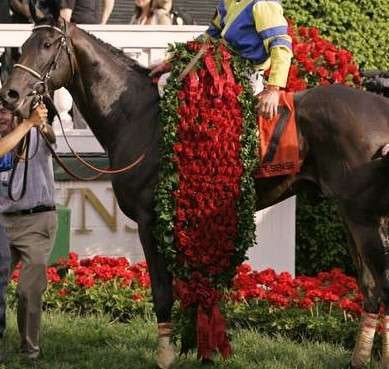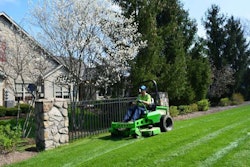 At the conclusion of the race, the winner of the Kentucky Derby is presented with the garland of roses.
At the conclusion of the race, the winner of the Kentucky Derby is presented with the garland of roses.Photo: Wikipedia
While there are many festivities nationwide happening this weekend, one that is especially famous is the Kentucky Derby held at Churchill Downs Racetrack, often referred to as “The Run for the Roses.”
Some may not know much about the Kentucky Derby or even have watched it, but it dates back to 1875, is the longest running sporting event in the United States and is known as “the most exciting two minutes in sports,” according to the official derby website.
The winner of this race is presented the beautiful and unique garland of roses, hence the race’s previously mentioned nickname, but what kind of time and care goes into making this garland?
The first garland of roses, as it exists today, was made by Louisville florist Grace Walker in 1932, and was presented to Burgoo King after the 58th running.
In 1987, a new tradition for creating the garland was formed when local designers from the grocery store chain Kroger Company decided to meet in Louisville the day before the race to put it together with roses supplied by the store. The process is still done today and can take anywhere from 10-12 hours. Kroger invites the public each year to come out and watch the process of how it’s all done.
The garland stretches 122 inches long, 22 inches wide and weighs approximately 40 pounds. The roses, which today are now known as freedom roses, are sewn into a green satin lining featuring the embroidered seal of the Commonwealth of Kentucky on one end and the Churchill Downs event mark on the other.
At the center of the garland is the ‘crown of roses,’ which features one rose for each thoroughbred running in the derby that year, as well as a single rose pointing upward in the center. According to the derby’s website, this center rose symbolizes the “struggle and heart necessary to reach the Derby Winner’s Circle.” More than 400 freedom roses are placed on the garland each year.
The freedom rose first received its name after the events that transpired on September 11, 2001. They were dubbed “the perfect patriotic red,” and were given the name ‘freedom rose’ as a tribute to the victims and their families, as well as the men and women currently serving in the armed forces.
Freedom roses typically bloom in mid-spring to mid-fall and thrive in USDA Hardiness Zones 5-9. It is a hybrid tea rose and requires moderate to full sun exposure. Featuring medium to dark green, glossy, ovate leaves, freedom roses can vary in size but typically can grow to a height of 3-4 feet. Soil for freedom roses needs to remain moist but well drained for optimum growing.












